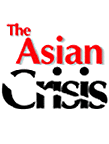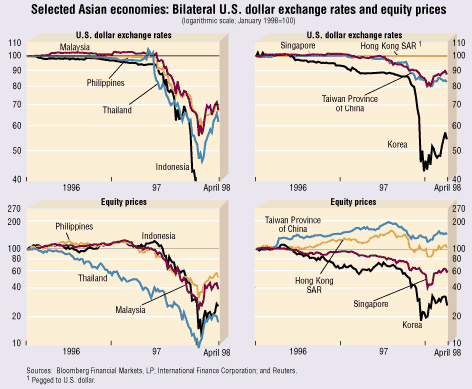 About F&D Subscribe Back Issues Write Us Copyright Information Use the free Adobe Acrobat Reader to view a pdf file of this article
|
|
|
|
The Asian Crisis: Causes and Cures IMF Staff The financial crisis that struck many Asian countries in late 1997 did so with an unexpected severity. What went wrong? How can the effects of the crisis be mitigated? And what steps can be taken to prevent such crises from recurring in the future? THE EAST ASIAN countries at the center of the recent crisis were for years admired as some of the most successful emerging market economies, owing to their rapid growth and the striking gains in their populations' living standards. With their generally prudent fiscal policies and high rates of private saving, they were widely seen as models for many other countries. No one could have foreseen that these countries could suddenly become embroiled in one of the worst financial crises of the postwar period. What went wrong? Were these countries the victims of their own success? This certainly seems to have been part of the answer. Their very success led foreign investors to underestimate their underlying economic weaknesses. Partly because of the large-scale financial inflows that their economic success encouraged, there were also increased demands on policies and institutions, especially those safeguarding the financial sector; and policies and institutions failed to keep pace with these demands (see table). Only as the crisis deepened were the fundamental policy shortcomings and their ramifications fully revealed. Also, past successes may have led policymakers to deny the need for action when problems first appeared.
Several factors—both domestic and external—probably contributed to the dramatic deterioration in sentiment by foreign and domestic investors:

To contain the economic damage caused by the crisis, the affected countries introduced corrective measures. In the latter part of 1997 and early 1998, the IMF provided $36 billion to support reform programs in the three worst-hit countries—Indonesia, Korea, and Thailand. The IMF gave this financial support as part of international support packages totaling almost $100 billion. In these three countries, unfortunately, the authorities' initial hesitation in introducing reforms and in taking other measures to restore confidence led to a worsening of the crisis by causing declines in currency and stock markets that were greater than a reasonable assessment of economic fundamentals might have justified. This overshooting in financial markets worsened the panic and added to difficulties in both the corporate and financial sectors. In particular, the domestic currency value of foreign debt rose sharply. While uncertainties persisted longer in Indonesia, strengthened commitments were made elsewhere to carry out adjustment reforms. Appropriate strategies The strategies needed to restore confidence and support a resumption of growth include a range of measures, tailored to tackle the particular weaknesses of each country. These strategies are the basic ingredients of the IMF-supported programs in Indonesia, Korea, and Thailand.
Prospects for recovery In all of the countries at the center of the financial turmoil, its consequences have taken the form of a substantial shrinkage of investment and consumption, coupled with a rapid improvement in trade positions. For 19 98 as a whole, the aggregate current account of Indonesia, Korea, Malaysia, the Philippines, and Thailand is forecast to be $20 billion in surplus, compared with deficits of $27 billion in 1997 and $54 billion in 1996. This forced improvement in the external situation will help to offset declines in domestic demand, but output is expected to stagnate in Indonesia and Korea, and to fall slightly in Thailand. There have already been some recoveries of exchange rates and stock markets, and as the needed policies are carried out and external positions improve, confidence should recover further during 1998. This will pave the way for a moderate rebound of growth in 1999 and solid recovery by 2000. The experiences of Argentina and Mexico following the "tequila crisis" of 1994–95, as well as the experiences of many other countries in similar situations, demonstrate that when policymakers are prepared to address the root causes of a financial crisis, economic recovery is likely to begin a year or so after a crisis peaks. In the East Asian case, the severity and importance of the crisis in the financial sector and other structural weaknesses in the countries concerned mean that necessary corrective measures are likely to take longer to implement than in crises that can be resolved mainly by macroeconomic adjustment. At the same time, the deep declines that have occurred in currency and financial markets suggest there is scope for relatively sharp rebounds as confidence recovers. Moral hazard Some commentators have argued that the international community's assistance to countries suffering from financial crises will only encourage more reckless behavior by borrowers, lenders, and investors—a phenomenon that is known as "moral hazard." Such moral hazard exists when the provision of insurance against a risk encourages behavior that makes the risk more likely to occur. In the case of IMF lending, concern about moral hazard stems from a perception that such assistance might weaken policy discipline and encourage investors to take on greater risks in the belief that they will only partially suffer the consequences if their investments sour. In fact, though, one of the fundamental purposes of the IMF is to limit the economic and social costs of crises. The experience of the Great Depression taught policymakers that the damage caused by systemic financial crises can be devastating and can have a global impact. This justifies a public policy role in avoiding deep and damaging crises. Nonetheless, in some instances the fact that IMF financing is available could increase the incentive for risk-taking by both potential borrowers and lenders. Policymakers could pursue more risky policies, knowing that the IMF would be there if their policies failed. Likewise, lenders could take excessive risks if they believe that an IMF loan would enable a government or its banks to pay their debts if the country fell into financial trouble. In its policy advice, the IMF seeks to ensure that the parties to private transactions bear the costs of their actions. Policy advice on banking sector restructuring typically includes the closing of insolvent institutions and equity writedowns in institutions that are restructured. However, depositors may need to be protected up to certain limits, or safeguarded more broadly, if there is a risk of a general run on a banking system. It may therefore be difficult to avoid moral hazard altogether with respect to banks' foreign creditors, although there may be scope for arrangements in which these creditors roll over short-term loans at terms they would normally not choose to accept. Given the significant costs of financial crises for borrowers and lenders alike, it seems highly unlikely that imprudent lending and investment decisions are primarily the result of moral hazard created by the involvement of the IMF and other international financial bodies. Crises also reflect misjudgments or "irrational exuberance" that lead investors and banks to underestimate the risks in emerging markets (and then to overreact when sentiment begins to change). This underscores the need to ensure that investment decisions are supported by timely and accurate information to enable investors, lenders, and borrowers to be fully aware of a country's situation and vulnerabilities. Forestalling future crises The East Asian crisis of 1997–98 and the Mexican crisis of 1994–95 are the latest of a large number of crises in the past two decades. These crises have been costly for the countries directly affected—both those where the crises began and those that might have escaped them but for spillover and contagion effects. Obviously, in view of these costs, the foremost concern for policymakers and financial markets is how to identify the causes of crises and prevent them. It is, of course, impossible to predict crises reliably. Further, for crises arising from pure contagion effects, early warning signals may not be available because these crises arise from unpredictable market reactions. It is feasible, however, to identify the kinds of weaknesses that typically make economies vulnerable to financial crises, whether or not a crisis does in fact materialize. Analysis suggests that the chances of a currency or banking crisis are increased when the economy is overheated: inflation is high, the real exchange rate has appreciated, the current account deficit has widened, domestic credit has been growing rapidly, and asset prices have become inflated. An analysis further indicates that real appreciation of the domestic currency, an excessive expansion of domestic credit, and a rapidly rising ratio of broad money to international reserves are signals of vulnerability to pressures in currency markets. Equity price declines and deteriorations in the terms of trade can also signal vulnerability to a crisis, as can a rise in world interest rates. Indeed, a number of these variables indicated the emergence of vulnerabilities in the Asian countries most affected by the recent crisis. Indicators of vulnerability do give false signals, however, and they cannot predict crises. A key task for future policymakers is to identify and address vulnerability before crises erupt. While it may be impossible to detect and correctly interpret warning signals for all types of crises early enough, preemptive actions have meant that many potentially serious crises have been avoided in the past. In some cases, countries may need to adapt their exchange rate regime. Such mechanisms as currency pegs and currency unions have served many countries well and have helped to support their stabilization efforts. When countries adopt a pegged or fixed-rate arrangement, a number of preconditions must be met. For example, the anchor currency and the rate at which the peg is set have to be appropriate and policies must be attuned to maintaining the rate. For some economies, the balance of costs and benefits seems to be shifting in favor of greater exchange rate flexibility, partly in order to avoid the risk that a fixed exchange rate might lead to excessive foreign currency exposure. The decision to exit a fixed currency arrangement is difficult, however, and ideally should be taken in a period of calm. All countries benefit from access to global capital markets and from the improvement in resource allocation associated with market-based competition for financing. Among these benefits is the competition in domestic financial sectors that the entry of foreign firms allows. At the same time, there are important preconditions for an orderly liberalization of capital movements. These include, above all else, a robust financial system supported by effective regulation and supervision of financial institutions. During the transition to an open capital account regime with a liberalized domestic financial sector, market-based instruments—such as reserve requirements on foreign currency deposits and short-term borrowing—may help to moderate financial flows. Prudential limits on foreign currency exposure in the financial system are also essential. The liberalization of domestic financial systems should precede—or at least accompany—the opening up to foreign investors, since this will promote the development of domestic capital markets. Such a step would reduce the risk that capital inflows would become a substitute for the mobilization and effective intermediation of domestic financial resources.
This article is drawn from the IMF's World Economic Outlook, May 1998 (Washington).
|
||||||||||||||||||||||||||||||||||||||||||||||||||||||||||||||||||||